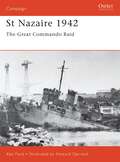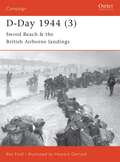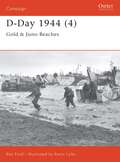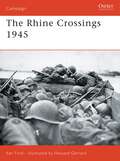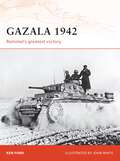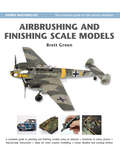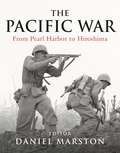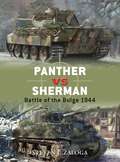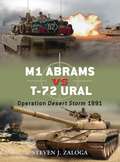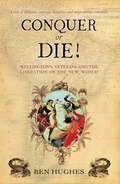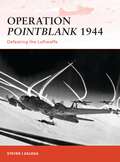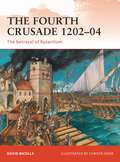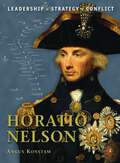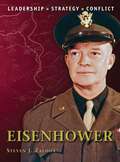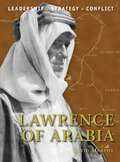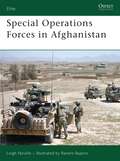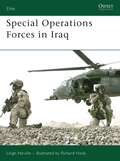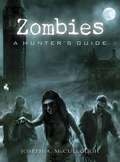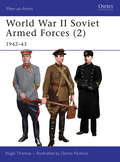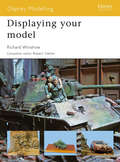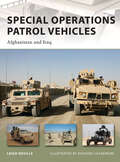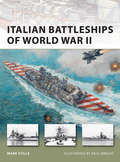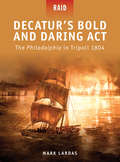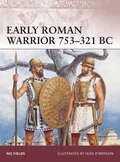- Table View
- List View
St. Nazaire, 1942
by Howard Gerrard Ken FordThe raid on the port of St. Nazaire in March 1942 by a sea-borne task force from British Combined Operations remains one of the most daring actions of World War II. The port lies at the mouth of the River Loire and in 1942, as well as a U-Boat base, contained the massive 'Normandie' dock, the only facility on the Atlantic coast large enough to accommodate the German pocket battleship Tirpitz. This book tells the story of the raid on St. Nazaire that denied the use of the dock to the Tirpitz, the sister ship of the Bismarck, and constituted a crucial victory in the Battle of the Atlantic.
D-Day 1944: Sword Beach and the British Airborne Landings
by Howard Gerrard Ken FordAt 0016hrs on 6 June 1944 a Horsa glider ground to a halt a mere 60 yards from the Orne Canal bridge at Bénouville in Normandy. A small group of British paratroopers burst from it and stormed the bridge within minutes. The Allied liberation of Nazi-occupied Europe had begun. Within a few hours landing craft would swarm towards Ouistreham as British 3rd Division stormed ashore at Sword Beach. The battle would then begin to break through to relieve the paratroopers. In the third of the D-Day volumes Ken Ford details the assault by British 6th Airborne Division and the British landings on Sword Beach that secured the vital left flank of the invasion.From the Trade Paperback edition.
D-Day 1944: Gold and Juno Beaches
by Ken Ford Kevin LylesOperation Overlord, the Allied invasion of Normandy, was the greatest sea-borne military operation in history. At the heart of the invasion and key to its success were the landings of British 50th Division on Gold Beach and Canadian 3rd Division on Juno Beach. Not only did they provide the vital link between the landings of British 3rd Division on Sword Beach and the Americans to the west on Omaha, they would be crucial to the securing of the beachhead and the drive inland to Bayeux and Caen. In the fourth D-Day volume Ken Ford details the assault that began the liberation of Nazi-occupied Europe.
The Rhine Crossings 1945
by Howard Gerrard Ken Ford'The last great heave of war,' according to Churchill, took place with the crossing of the Rhine in 1945. No invading army had crossed this great river since Napoleon's in 1805, and the task fell to Field Marshal Montgomery's 21st Army Group. Opposing them were the forces of a failing fascist regime, including battalions of old men and boys, strengthened by several formations of crack troops, including paratroopers and Panzer Grenadiers.This book details the devastating Anglo-American assault from Arnhem, starting with the battle of Arnhem, and leading on to the successful crossing of the Rhine and eventual breakout, and continuing with the advance across northern Germany. Including comprehensive details on all aspects of the operation, including the amphibious assault, airborne landings, special forces' attack and armored land battle, this book charts the history of the last great set-piece battle of the war, second in magnitude only to the Normandy invasion, that ultimately brought the defeat of Hitler's Nazi regime one step closer.From the Trade Paperback edition.
Gazala 1942: Rommel's Greatest Victory
by John White Ken FordGazala was Rommel's greatest victory. After a period of stalemate in the desert war, during which both the British Eighth Army and the Afrika Korps had rested and regrouped, he carried out a daring flanking movement around the strong Allied defensive position. The British command could not match Rommel's masterly co-ordination of armor, artillery and infantry, even when encircled in an area that became known as "the Cauldron", and his outstanding generalship and a timely break-through by his Italian troops enabled him to win a clear victory after 16 days of fierce fighting. However, although the strategically important town of Tobruk quickly fell, Gazala was actually a high-water mark and failure to break the British at Alam Halfa two months later was followed by defeat for the over-extended Afrika Korps by the greatly strengthened Eighth Army at El Alamein. In this important addition to the Campaign series' coverage of the North African desert war, regular contributor Ken Ford vividly portrays the "Desert Fox" at the height of his powers.
Airbrushing and Finishing Scale Models
by Brett GreenA convincing paint finish is essential for any model, be it military or civilian, aircraft, vehicles, figures or even background items such as terrain or buildings - and good airbrushing and finishing techniques can be the key to creating a superior model. Over the last few years there have been huge strides made in the development of airbrushes, paints and thinners, and consequently, this new book will provide up-to-date practical information and illustrated techniques to take full advantage of these new technologies.Brett Green details the prerequisites of airbrushing, including the different types of spray equipment and air sources available, offering advice on appropriate thinners, paint ratios and air pressures to ensure the most appropriate paint coverage across a range of different airbrushing applications. He then examines various airbrushing techniques across a wide range of models. Ten step-by-step, illustrated case studies ranging from heavily weathered military aircraft to pristine, high gloss motor vehicles, science fiction models, fantasy figures, groundwork and buildings will complete this in-depth guide to getting the best results on your models.From the Hardcover edition.
The Pacific War
by Daniel MarstonA new paperback edition of one of the bestselling World War II Osprey titles, The Pacific War Companion brings together the perspectives and insights of world-renowned military historians. From the Japanese attack on Pearl Harbor through the release of the atomic bombs on Hiroshima and Nagasaki, the conflict in the Pacific was marked by amazing tactical innovations, such as those in amphibious warfare, and horrific battles that raged in the unforgiving climate of the island jungles. Each chapter in this book focuses on a different aspect of this conflict, from the planning of operations to the experiences of the men who were there.
Panther vs Sherman: Battle of the Bulge 1944
by Steven J. Zaloga Howard GerrardZaloga offers a fascinating comparison of the combat performance of the two most important tanks involved in the crucial fighting of 1944, the Sherman and the Panther. Examining the design and development of both tanks, Zaloga notes the obvious superiority that the Panther had over the Sherman and how the highly engineered German tank was eventually beaten back, not necessarily by the improvements made to the Sherman, but rather by the superior numbers of tanks that the Allies were able to put into the field.Putting the reader into the heart of this battle between quality and quantity Zaloga examines the tactical intricacies of the battles between these two rivals. Using a compelling account of the ferocious fighting in the Ardennes region to explain the successes and failures of each tank he also highlights the fact that a tank can only be as good as its crew, weighing up the impact of low morale, high cost and mediocre crew training on the Panthers superiority. Packed with full-colour battlescenes, technical drawings, photographs, digital gunsight views, extracts from crew training manuals and real combat reports, this book brings to life the titanic battles between the Sherman and the Panther.
M1 Abrams vs T-72 Ural: Operation Desert Storm 1991
by Steven J. Zaloga Jim LaurierThe Gulf War bore witness to a number of deadly encounters between these two great adversaries. Heavily armored, highly mobile and capable of killing at over 2500m the M1 Abrams is, to this day, a veritable fighting machine. Superior to both Iraq's Soviet era T-55 and T-62 tanks, nearly all sources claim that no Abrams tank has ever been destroyed by enemy fire. Despite entering service in 1980, the M1 Abrams remained untested in combat until the Gulf War in 1991, where it was to be confronted by its archenemy the Iraqi-assembled Soviet-designed T-72. Entering production in 1971, the T-72 arguably outstripped its contemporaries in a balance of mobility, protection and firepower. By the time of Operation Desert Storm, however, the tables had turned and the tank suffered due to low quality ammunition and poorly trained crews. In this fascinating study, Steven Zaloga pits these two great fighting machines against one another, plotting the development of the Cold War until both tanks met in combat in the deserts of Iraq and Kuwait. From the Trade Paperback edition.
Conquer or Die!
by Ben HughesIn 1815, just after the battle of Waterloo, over 6,000 British volunteers sailed across the Atlantic to aid Simon Bolivar in his liberation of Gran Columbia from her Spanish oppressors. The expeditions were plagued with disaster from the start, when one ship sank shortly after leaving Portsmouth with the loss of almost 200 lives. Those who reached the New World faced disease, wild animals, mutiny and desertion. Conditions on campaign were appalling, massacres were commonplace, rations crude, pay infrequent and supplies insufficient. Nevertheless, those who endured made key contributions to Bolivar's success. This book tells the fast-paced and entertaining story of the British volunteers from the raising of the regiments in Britain to the perils of campaigning to their defiant stand at the battle of Carabobo. Drawing on the volunteers' memoirs, letters and journals, supported by unpublished documents and newspaper reports, Conquer or Die! is the result of research across two continents. It is the first narrative on the subject for over eighty years.From the Hardcover edition.
Operation Pointblank 1944
by Steven ZalogaOperation Pointblank was the code name for the United States Army Air Force's attempt to destroy German fighter capability through the use of daylight strategic bombing in advance of the D-Day landings. Launched in 1943, the operation immediately met with severe problems, most notably the horrible attrition experienced by the US bomber forces. However, with the arrival of the P-51 Mustang, the United States was able to equip the fighters to fly on long-range-bomber escort missions and take the fight to the Luftwaffe in the skies over Germany. This book examines the entire operation from both the Allied and the German perspectives, covering all the main decisions and technological innovations made by both sides in this epic struggle.From the Trade Paperback edition.
The Fourth Crusade 1202-04
by David Nicolle Christa HookThe Fourth Crusade was the first and most famous of the 'diverted' crusades, that is, ones diverted from their originally intended target. It was also the first to be directed against a fellow Christian, though Orthodox, state. Initially preached (from 1198 onwards) as a campaign against Ayyubid Egypt, which was correctly seen as the most potent threat to the Latin or 'Crusader' Kingdom of Jerusalem, its first Christian target was the city of Zadar in what is now Croatia. The greater part of the crusading army then attacked the Byzantine capital of Constantinople, again as part of their obligations to Venice. The result was a siege and the first capture of that great city in 1203. This title will highlight all the intrigue, deception, and betrayal of this tumultuous Crusade.From the Trade Paperback edition.
Horatio Nelson
by Peter Dennis Angus KonstamThe most famous admiral in history, Horatio Nelson's string of naval victories helped secure Britain's place as the world's dominant maritime power, a position she held for more than a century after Nelson's death. A young officer during the American Revolution, Nelson rose to prominence during Britain's war with Revolutionary France, becoming a hero at the battle of Cape St. Vincent. He went on to win massive victories at the Nile and Copenhagen, before leading the British to their historic victory at Trafalgar in 1805. But, in that moment of his greatest glory, Nelson was struck down by a French sharpshooter. Today Nelson is revered as an almost mythical figure - a naval genius and a national hero. He was also a deeply flawed individual whose vanity, ego and private life all threatened to overshadow his immense abilities. This book reveals the real Nelson.From the Trade Paperback edition.
Eisenhower
by Steven Zaloga Steve NoonDwight Eisenhower represented a fundamentally new type of military commander in the 20th century: commander as manager rather than the traditional warrior commander. Armies had become so large and military coalitions so dependent on politics that this new type of commander emerged. Eisenhower never fought in a single battle, but he commanded the most modern and powerfully armed force to fight in Europe. As Supreme Commander of the Allied Expeditionary Force, Eisenhower had at his disposal not only the British, US, and French armies, but the RAF, USAAF, Royal Navy and US Navy-Atlantic. This book explores every aspect of his military career.From the Trade Paperback edition.
Lawrence of Arabia
by Giuseppe Rava David MurphyThomas Edward Lawrence, more popularly known as Lawrence of Arabia, was one of the most iconic figures of the 20th century, immortalized on stage and screen, whose exploits in the Middle East in the second half of World War I helped shape the campaign in that part of the world. In the course of two brief years, Lawrence emerged as one of the main strategic and tactical minds behind the Arab Revolt. He went from being an obscure staff officer to the rank of full colonel and became one of the men who shaped the modern Middle East. From being a pure amateur, he also developed desert tactics that would be used throughout World War II and afterwards. This new Command title provides an in-depth analysis of every aspect of Lawrence's storied military career.From the Trade Paperback edition.
Special Operations Forces in Afghanistan
by Ramiro Bujeiro Leigh NevilleIntelligence specialist Leigh Neville identifies, describes and illustrates the Special Operations Forces (SOF) of the US and other Allied (Coalition) forces committed to the 'War on Terror' in Afghanistan since 2001, providing a fascinating insight into specific operations detailing weapons, equipment and experiences in combat. With a surprising amount of recently unclassified material from government departments that are yet to be published in the mass media, this is a ground-breaking analysis of the largest mobilization of Special Forces in recent history. Extensive first-hand accounts provide an eyewitness perspective of the fighting including a description of the assault on Tora Bora, all illustrated with an array of unpublished photos and full color artwork. Containing detailed information on the US Delta Force, the British SAS, Australian and Canadian Special Forces as well as CIA and MI6 operational units this book provides a crucial study of their skills and success amidst Afghan mountains.From the Trade Paperback edition.
Special Operations Forces in Iraq
by Leigh Neville Richard HookIntelligence specialist Leigh Neville identifies, describes and illustrates the Special Operations Forces (SOF) of the US and other Allied (Coalition) forces committed to war in Iraq since 2003, providing a fascinating insight into specific operations, detailing weapons, equipment and experiences in combat. With a surprising amount of recently declassified material from government departments that are yet to be published in the mass media, this is a ground-breaking analysis of the largest mobilization of Special Forces in recent history. With extensive first-hand accounts providing an eyewitness perspective of the fighting on the ground and including information on the US Delta Force, the British SAS, Australian and Canadian special forces as well as CIA and MI6 operational units this book provides a crucial study of their skills and success in Iraq from the Battle of Debecka to storming the safe house of Uday Hussein. In a controversial war that has been plagued by high fatalities and military blunders, this book highlights the successes enjoyed by Special Forces operatives. This book serves as a companion volume to Elite 163: Special Forces Operations: Afghanistan.From the Trade Paperback edition.
Zombies
by Joseph McculloughThe dead have always stalked the dark corners of the earth. Since World War II, the number of zombie outbreaks has increased every year, while governments desperately try to cover up the facts. Zombies: A Hunter's Guide contains all of the information necessary to recognize and combat this growing threat. Beginning with an explanation of the historical origins of zombies, it follows their history straight through to the threat they pose to the world today. All varieties of zombie are catalogued and examined, giving their strengths and weakness, with a special emphasis on recognition and elimination. Finally, the book covers the tactics and equipment used in zombie fighting. Accompanied by numerous full-color reconstructions to help with identification, this book is a must for anyone on the frontlines of the Zombie Wars.From the Trade Paperback edition.
World War II Soviet Armed Forces
by Nigel Thomas Darko PavlovicThis title presents a detailed analysis of the Soviet Army at the outbreak of World War II (1939-1945), including the Red Army's campaigns against Japan on the Manchurian plains as well as in Finland. It also covers the Red Army's first operations during Operation Barbarossa when the Red Army was forced to defend Mother Russia against the German onslaught. With a breakdown of all the armed forces including the army, air force, paratroopers, navy and NKVD troops, author Nigel Thomas gives special attention to the evolution of uniforms, equipment and insignia with the introduction of new regulations in 1935 and 1940.
Displaying your Model
by Richard WindrowWhen a modeller finishes his creation he has to take an important decision on how to display it. Should he place it in a diorama, a simple display case, a mirrored stand, individual figure domes, a deep 'picture frame box, or possibly even a 'light box? This book covers all the various methods and techniques, and will be of great use to the entry-level modeller as well as the more experienced one. It features a series of dioramas and vignettes, along with an extensive gallery of other modellers' approaches to the subject, giving a range of skills and approaches from across the broad spectrum of international modelling. Book jacket.
Special Operations Patrol Vehicles
by Leigh Neville Richard ChasemoreThe patrol vehicles used by Special Operations Forces in Afghanistan and Iraq vary quite dramatically between the theaters as well as amongst the Coalition members, and have been developed and upgraded to meet the demands of the deployment. Covering all the major Coalition nations, Leigh Neville continues his look at the elite forces deployed in Operations Enduring Freedom and Iraqi Freedom with this analysis of their vehicles.Tracing the evolution of the vehicle types, from their historical precedents, through their designs to their operational developments, he discusses their advantages and disadvantages, along with their tactical employment. From the mine-protected vehicles used to counter the IED threat in Iraq, the use of Strykers as armored raiding platforms by the US Rangers, to the civilian vehicles adapted for military service by both Coalition troops and Private Military Contractors in the regions, this book uses rare in-theater photographs and color artwork to show the variety and inventiveness of the patrol vehicles being used in combat today.From the Trade Paperback edition.
Italian Battleships of World War II
by Paul Wright Mark StilleOften overlooked as a naval power of WWII, Italy's Regia Marina was, upon the declaration of war against France, the fourth largest navy in the world. Despite its numbers, the Italian fleet was made up of largely obsolete vessels, none being equipped with radar, and had a reputation for having inadequately-trained crews. Added to these drawbacks, the Italian commanders did not enjoy the discretion of command at sea that their counterparts in the service of other nations did, being directed closely by the Supermarina (Italian Naval Headquarters). Despite these obstacles, and the heavy losses inflicted upon the fleet by the Royal Navy while in harbour at Taranto, the battleships of the Italian Navy enjoyed a good reputation for being well-designed, and served with courage and determination at Punto Stilo/Calabria, Sirte, Cape Spartivento, and Cape Matapan. Mark Stille details, with the aid of many stunning photographs, including several from the Italian Navy's own archives, the battleships of one of the forgotten navies of WWII.From the Trade Paperback edition.
Decatur's Bold and Daring Act- The Philadelphia in Tripoli 1804
by Steve Noon Mark LardasOn a dark night in 1804, Lt. Stephen Decatur and a team of hand-picked men, slipped into Tripoli harbor in a small boat. Their target was the USS Philadelphia. Captured by the Barbary pirates four months previously, the Philadelphia had been refitted to fight against her former masters. Decatur's mission was to either recapture the ship, or failing that, burn her to the waterline. This book recounts one of the greatest raids in American military history, an event that propelled Stephen Decatur to international renown, and which prompted Horatio Nelson to declare it 'the most bold and daring act of the age'.
Early Roman Warrior 753-321 BC
by Nic Fields Sean O'BrogainThe prototypical 'Roman Legionnaire' often seen on television and in movies is actually the product of nearly a millennium of military development. Far back in the Bronze Age, before the city of Rome existed, a loose collection of independent hamlets eventually formed into a village. From this base, the earliest Roman warriors launched cattle raids and ambushes against their enemies. At some point during this time, the Romans began a period of expansion, conquering land and absorbing peoples. Soon, they had adopted classical Greek fighting methods with militia forming in phalanxes. This book covers the evolution of the earliest Roman warriors and their development into an army that would eventually conquer the known world.From the Trade Paperback edition.
Fairbairn-Sykes Commando Dagger
by Howard Gerrard Leroy ThompsonThe Fairbairn-Sykes Commando dagger has become iconic as the most widely recognized fighting knife in the world. The origins of the dagger can be traced to Shanghai in the 1930s where W. E. Fairbairn and US Marine officers including Sam Yeaton carried out experiments in developing what they considered the perfect knife for close combat. When Fairbairn and Sykes became instructors for the Commandos, they refined the design which would evolve into the classic Fairbairn-Sykes dagger. The dagger was first used during early Commando raids into occupied Europe but saw action in every theatre of World War II (1939-1945). US Rangers and Marines who had trained with the Commandos took their Fairbairn-Sykes daggers home which also influenced the development of American Special Forces daggers. The Fairbairn-Sykes remained in use with many units after the war, and has become a symbol of commando and special forces units throughout the world.From the Trade Paperback edition.
